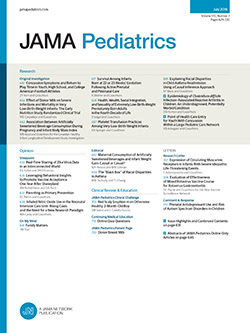Subcutaneous Nitroglycerin to Prevent Radial Artery Occlusion in Pediatric Patients: A Randomized Clinical Trial.
IF 18
1区 医学
Q1 PEDIATRICS
引用次数: 0
Abstract
Importance Pediatric patients are at an increased risk of postprocedural radial artery occlusion (RAO) owing to their small vessels and high tendency for vasospasm after catheterization. Although subcutaneous nitroglycerin increases the success rate of radial artery catheterization by vasodilation and preventing vasospasm, its effect on RAO prevention after catheter removal remains unknown. Objective To evaluate the efficacy and safety of subcutaneous nitroglycerin for RAO prevention. Design, Setting, and Participants This double-blind randomized clinical trial was conducted at a single tertiary center and included pediatric patients younger than 3 years who required radial artery catheterization during general anesthesia. Study data were analyzed from April to July 2025. Interventions Patients were randomized to receive either subcutaneous nitroglycerin (5 μg/kg/0.5 mL) or normal saline (0.5 mL) above the chosen radial artery before radial arterial catheterization and catheter removal under ultrasound guidance. Main Outcomes and Measures The primary outcome was the RAO incidence after catheter removal, assessed using the reverse Barbeau test with pulse oximetry on the ipsilateral index finger. Results A total of 200 pediatric patients were initially enrolled, but 68 were excluded for protocol violations. In the per-protocol analysis with 132 participants (median [IQR] age, 5.5 [2.0-16.6] months; 73 female [55.3%]), RAO incidence was lower in the nitroglycerin group than in the control group (25.4% [17 of 67] vs 73.8% [48 of 65]; P < .001; odds ratio [OR], 0.12; 95% CI, 0.06-0.26; absolute risk reduction, 48.5%; 95% CI, 33.6%-63.4%). After catheter removal, the nitroglycerin group showed higher peak blood flow velocity (mean [SD], 13.0 [11.0] cm/s vs 7.4 [9.2] cm/s; 95% CI for mean difference, 2.1-9.1 cm/s; P = .002) and perfusion index (mean [SD], 1.37 [1.09] vs 0.65 [0.49]; 95% CI for mean difference, 0.43-1.01; P < .001) of the radial artery than did the control group. There was no significant intergroup difference in RAO duration. There was no hypotension or localized adverse effects. Conclusions and Relevance Subcutaneous nitroglycerin injection before radial artery catheterization and catheter removal significantly reduced the incidence of RAO after catheter removal and may promote safe recovery in pediatric patients younger than 3 years. Trial Registration ClinicalTrials.gov Identifier: NCT05443061.皮下硝酸甘油预防儿科患者桡动脉闭塞:一项随机临床试验。
儿科患者术后桡动脉闭塞(RAO)的风险增加,因为他们的血管小,导管置入后血管痉挛的倾向高。虽然皮下硝酸甘油通过血管扩张提高桡动脉置管成功率,防止血管痉挛,但其对拔管后预防RAO的作用尚不清楚。目的评价硝酸甘油皮下注射预防RAO的有效性和安全性。设计、环境和参与者:该双盲随机临床试验在单一三级中心进行,纳入了在全身麻醉下需要桡动脉插管的3岁以下儿童患者。研究数据分析时间为2025年4月至7月。在超声引导下桡动脉置管拔管前,患者随机选择桡动脉皮下注射硝酸甘油(5 μg/kg/0.5 mL)或生理盐水(0.5 mL)。主要结局和测量主要结局是拔管后的RAO发生率,采用反向Barbeau试验和同侧食指脉搏血氧仪进行评估。结果最初共纳入200例儿科患者,但有68例因违反方案而被排除。在132名参与者(中位[IQR]年龄,5.5[2.0-16.6]个月;73名女性[55.3%])的方案分析中,硝酸甘油组的RAO发生率低于对照组(25.4% [67 / 17]vs 73.8% [65 / 48]; P < 0.001;优势比[OR], 0.12; 95% CI, 0.06-0.26;绝对风险降低48.5%;95% CI, 33.6%-63.4%)。拔除导管后,硝酸甘油组血流量峰值速度更高(平均[SD], 13.0 [11.0] cm/s vs 7.4 [9.2] cm/s;平均差异95% CI, 2.1 ~ 9.1 cm/s; P =。002)和灌注指数(平均[SD], 1.37 [1.09] vs 0.65[0.49];平均差异95% CI, 0.43-1.01; P <。(001)桡动脉的收缩比对照组明显。RAO持续时间组间差异无统计学意义。无低血压或局部不良反应。结论及意义:3岁以下儿童桡动脉置管拔管前皮下注射硝酸甘油可显著降低拔管后RAO的发生率,并可促进患儿安全康复。临床试验注册号:NCT05443061。
本文章由计算机程序翻译,如有差异,请以英文原文为准。
求助全文
约1分钟内获得全文
求助全文
来源期刊

JAMA Pediatrics
PEDIATRICS-
CiteScore
31.60
自引率
1.90%
发文量
357
期刊介绍:
JAMA Pediatrics, the oldest continuously published pediatric journal in the US since 1911, is an international peer-reviewed publication and a part of the JAMA Network. Published weekly online and in 12 issues annually, it garners over 8.4 million article views and downloads yearly. All research articles become freely accessible online after 12 months without any author fees, and through the WHO's HINARI program, the online version is accessible to institutions in developing countries.
With a focus on advancing the health of infants, children, and adolescents, JAMA Pediatrics serves as a platform for discussing crucial issues and policies in child and adolescent health care. Leveraging the latest technology, it ensures timely access to information for its readers worldwide.
 求助内容:
求助内容: 应助结果提醒方式:
应助结果提醒方式:


